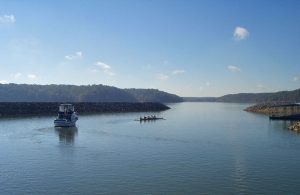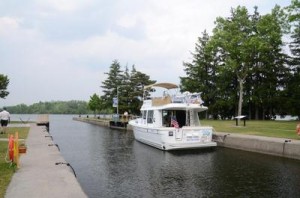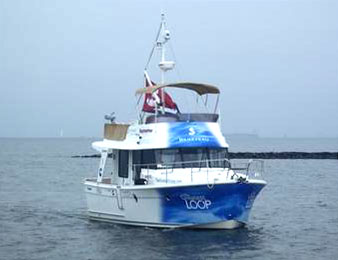Great Loop Boating Guide
The Great Loop is a 5,000 mile route that is one of America’s great boating adventure on the waterways of Eastern North America, in Canada and the USA.
The Great Loop is America’s great boating adventure on the waterways of Eastern North America, in Canada and the USA. You start out at your home port which can be anywhere from the navigable waters of Florida, Atlantic coast, Hudson River, the Great Lakes or Inland Rivers. Once you start the Loop you will typically cruise counter- clockwise until you are back in your home port. It’s a distance of 5,500 to 7,000 miles depending on the alternate routes you take, and the side trips you want to visit. Those who set out on this adventure are often referred to as "Loopers".
Buying The Right Boat For The Great Loop
There are many new and used vessels for sale that would be suitable if not ideal boats for The Great Loop. That said, a vessel with a minimum range of at least 500 miles on one gas tank, a 6 foot maximum draft and preferably an air height of less than 19 feet (due to bridges) are the most important technical features. A 22 foot air height should clear most bridges, with 19 being the safest. Many sailboats can and do lower their masts at the bridge, and are thus an exception to the 19 feet height requirement. Boats with larger masts between 50-65 feet high will have to stop for many drawbridges along the way, and may experience difficulty with tides and clearance. Boat with masts higher than 65 feet generally will not be able to traverse the ICW.
The right boat is not the biggest boat you can afford but rather the best boat you will be comfortable living aboard for a long duration. Most boats will sleep 4 people and a small dog or cat.

The Great Loop Boating Guide. Photo: Bob Duthie
You should consider contacting a boat broker to help you find the right boat for your purposes. Look for a boat buyer’s broker that is devoted to your needs. Seller’s brokers work for the seller and are devoted to their needs. Start with the type of boat that meets the criteria above that can do the Loop safely - either a sailboat or a power boat.
Good Sailboats For The Great Loop
Sailboats are the slower option of course and must have an engine, carry a minimum of two people and have comfortable beds - as well as be able to deal with both cold and hot days. As a practical matter, sailboats must remove their masts from Chicago to Mobile Bay to get under the bridges.
Ideal Powerboats For The Great Loop
Power boats are obviously faster than sailboats and can cruise from 8 mph to 22 mph. Almost all Great Loop boats cruise at less than 12 mph to reduce fuel consumption and noise. It is also much more relaxing to go slow and enjoy the scenery. Loopers are generally not interested in racing and tend to choose trawlers or cabin cruisers for these reasons.
Canals are required by law to have no wake and a 5-mph speed. The only time for power boats to speed up is to avoid stormy weather and get to port safely.
Best Boat Engines for The Great Loop
Engines are a big issue when considering buying the right boat for The Great Loop. Should you have one engine or two engines? There are pros and cons to both. For example, two engines cost twice as much to buy and twice as much to change the oil and filters. However, the fuel consumption for two engines is actually only a bit more than one engine and it provides peace of mind to many boaters.
On the other hand, the leading cause of engine failure is dirty fuel and in that case, the second engine will quit as well. Either way, BoatUS Towing is the answer when engines fail throughout the USA waters and SeaTow services in Canada’s waters. The age-old debate of one or two engines will probably go on forever, so you'll have to make your own decision.
Great Loop powerboats typically have either inboard engines driving a shaft through the hull to a propeller or inboard-outboard engines which puts the gear box and propeller on the transom. Inboards take up a lot of space in the boat so that is an important consideration. Finally, there is a move toward all outboard engines on boats up to 35 or more feet long - which is a big advantage because of the added interior space available for stowage.
Another advantage of outboard engines is that they can be easily replaced or fixed without having to crawl around in an engine room resulting in less labor costs and more mechanics that can get at the engines. Some engines have 350 horsepower or more with many new outboard motor models released every year.
Should you get a boat with a fly bridge?
A flybridge is the best way for you to see where you're going in both directions. If the weather is cold you will need to install isinglass - which has to be cleaned and repaired. Isinglass also tends to block your view. You can have a fly bridge without isinglass if you have a lower helm and an upper helm. This gives you the best of both worlds.
If it is rainy or cold you can run your boat from the lower helm. Of course, you must see through the windshield and there are many boats that have a lower helm but make it difficult to see through the windshield. You will need to have a canvas Bimini over a flybridge to keep the sun off when you're cruising.
Required Boat Navigation Tools
The most important navigation tool is charts covering all the waters you will cruise on. You must buy these charts new or from Loopers that have completed the Loop. Charts are expensive, heavy and could cost $1,500 or more for a full set. You might think with a chart plotter you don’t need paper charts. Wrong! Printed charts are your only hope if your computer fails or your chart plotter fails. If your cellphone coverage fails, you are cruising blind.
The tools you need beside the charts, are an auto pilot, chart plotter and AIS. The auto pilot makes it easy to follow a course without hanging on to the steering wheel all day long. You follow the course on the chart plotter. Before you set out for the next day, you plot the course on the chart plotter.
As you clear the harbor you set the autopilot to follow a straight line. When the line turns, you adjust the knob on the autopilot to follow the new line. This is the safe way to cruise because you are always watching for other boats, floating debris, etc.
Connecting the autopilot to the chart plotter is not a good idea. There is a case where a boat crashed into a rock barricade because the captain forgot to plot the course around the barricade. The captain was in the cabin having dinner with friends and family and not looking out the window.
AIS (Automatic Identification System)
This is a relatively new system for Loopers and important to have. It is a digital VHF radio-based transponder system that can prevent collisions. It's like radar with precise position information and can see around bends in rivers. It is best to connect it to your chart plotter where it will show all the nearby ships. It is most useful to show the position of the big ships.
The screen also shows the speed of the ship, the direction it is going, and most importantly the name of the ship. When you know the name of a ship, you can call it by name, and it will answer you over the VHF. Ships are not likely to answer a call from anonymous boaters. By law all ships are required to have AIS. You are not required, and it is best to install a receive only unit.
There are so many boaters that have an AIS with transmit that your screen gets covered up with markers that you and the ships in a harbor can’t figure it out. Even worse the owners can’t find a way to shut the AIS off when they are docked.
Boat Generators
You will need to have a generator onboard so that you can charge the boat batteries when you don’t have shore power. Without batteries you have no way to watch TV, cook, charge your cellphone, or flush the head. Without a generator you can’t heat or cool the cabin with your AC system.
Anchor and Rode (Anchor Cable)
Remember the story about our engine quitting on Lake Erie? The first thing the Coast Guard asked when I called was if we had dropped the anchor. We had because otherwise our boat was rolling with the waves. With the anchor down the boat did not roll and the crew did not get sick. We were also far enough out from the Ohio coast that there was no danger of running aground.
The anchor is an essential piece of equipment on all cruising boats. You need at least one and two is better. There should be a chain of at least 20 feet, so it lies on the bottom when the anchor is dropped to the bottom. Then you should have 200-300 feet of rope line spliced into the end of the chain. You may also have 300 feet of chain on a second anchor.
A windlass is required to lower or raise the anchor. The windlass runs off the batteries and draws a great deal of power so it's important to keep the engine running when you lower or raise the anchor.
The Looper Lifestyle
Most loopers will carry two people onboard, and on occasion one or two friends along the way. A few take their children and home school them during the trip. Either way it's a unique, mobile lifestyle away from mainstream culture.
You may find friends will ask if they can join you at points along your trip, although those you invite will often cancel for various reasons, largely due to the unpredictability of life on the water.
Remember - you're on a long cruise and it is a one-way trip. Visitors fly to one port to start their cruise with you, then they must figure out how to get back from wherever you drop them off. Another issue for your guests will be the fluid nature of the dates you set along your course. On the Loop, all dates are subject to change due to weather and repair times.
Planning Your Great Loop Route
The Great Loop plan follows the seasons. You cannot cruise during the winter when rivers ice over and /or it is too cold for you live on your boat. Heat pump air conditioners don’t work well when the water temperature is much below 40 degrees Fahrenheit.
In the winter months, all marinas in the northern inland rivers close down completely so you can’t get water or fuel. The rules for the seasons say head north in April to avoid hurricane season and spend the summers on the Atlantic Coast and inland waterways to Chicago. Head south by September from Chicago and get to Mobile in October when the hurricane season is typically over.
If you plan on cruising during hurricane season your boat insurance will be far more expensive and you may not be covered at all without a plan to protect your boat. It is best to spend the winter in Florida and many Loopers go across to the Bahamas for a month or two.
What’s the Point of Doing the Great Loop?
You must be wondering after the discussions above why you would want to do the Loop. First it is an adventure unlike anything else. You will see the country the way it was when first discovered in the 1700’s. You will see the vast expanses between the big cities. You will anchor in endless marshes and see the stars at night well away from the city lights. You'll meet many folks along the way and make lifelong friends during the trip, building an amazing network of people and places to return to. When it’s all over you'll have made unforgettable memories and forged wonderful relationships that you'll likely hold on to for the rest of your life.
Starting Out on the Great Loop
Don’t do what we did! We bought our boat in April in Erie PA on Lake Erie. A month before we had learned how to run the boat during the sea trial. We had breakfast aboard and headed west on Lake Erie. It got rough and the waves stirred up the dirt in the fuel tanks which had not been cleaned. The diesel engine sputtered a few times and stopped dead.
We called the Coast Guard on our VHF radio and they said all the marinas are closed but they would come out and tow us 35 miles to a safe harbor. There was one marina open and the next day the port tank was drained, and new fuel added. Bad idea! Diesel engines recirculate fuel to only one tank. The starboard tank was shut off. We ran the port tank down to the bottom without noticing it and stalled the engine again.
There is no charge for the Coast Guard if there are no private rescue services. We joined BoatUS Towing immediately and they got us out of trouble several times. There is more to our story but the main lesson to learn is NEVER just hop in your boat and head out without learning to operate your boat close to port first. Take several days living on the boat and cruising short round trips before setting out on the Great Loop.
Great Loop Trip Costs, Gas and Statistics
It is very difficult to provide specific cost estimates, but you can work with my statistics to get an idea of how much you could spend. The cost of a good boat for navigating The Great Loop ranges from $50K to Millions. Some boats that are 40 years old will have a lower price, but you could easily double that cost with repairs and outfitting it with modern equipment.
We did the Loop in four stages: 173 days aboard, 11 nights at anchor, 157 nights at docks, 1 night underway. We started on Oct 17, 2003 and finished July 18, 2005. Below are some of the specific statistics logged:
- Elapsed time: 21 months
- 692 Engine hours
- 140 generator hours
- 1,745 gallons diesel
- 2.52 gal/hr
- 5,614 miles 3.22 miles/gal
- 4,429 photos
Great Loop Destinations and Favorite Places
Cumberland Island, Georgia
We had two favorite places along The Great Loop. The first was Cumberland Island, an 18-mile-long barrier island off the coast of Georgia. You anchor and row into the small dock. You then walk through a forest of southern trees, come out before a sand dune with turkeys walking around, and finally view 18 miles of sand beach. The odds of seeing anyone else on the wide and long beach are very small. You are going back thousands of years the way the world was.
Benjamin Islands, North Carolina
Our second favorite place was the North Channel’s Benjamin Islands on Lake Huron. We anchored with three sailboats on South Benjamin Island in a bay that is sheltered on 3 sides. The water is crystal clear and lets you see your anchor in sand 15 feet below. There are high smooth rock cliffs on each side of the entrance. I took the dingy to shore and climbed to the top of a cliff for an incredible southern view of the North Channel. In a sheltered place high on the rocks, I found a cluster of four very rare Pink Lady Slipper Orchids.
Conclusion
If you enjoy these kinds of Looping stories, I highly suggest you read “Hero's Loop”. This is the funniest Loop book since "Honey Let's Get a Boat". Hero is the dog that the Liles took on their cruise of the Great Loop. If anything can go wrong on a cruise, Mike Lile learned all about it and survived to write his story.
You'll also need to join the nonprofit AGLCA (America’s Great Loop Cruising Association) where you will get all kinds of information from members. You can also attend rendezvous and meet current loopers, want-to-do-it Loopers, and the Gold Loopers that have completed the Loop. The website is at greatloop.org












